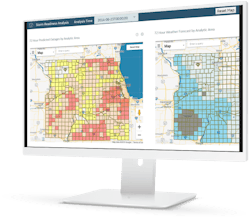Grid Analytics Drive Change in Severe Weather Response Planning
Climate change is driving severe weather events, impacting network assets, productivity and customer satisfaction. Hurricanes, tornadoes, wildfires, excessive ice, major flooding and heat waves are all growing in frequency and intensity. Combine this extreme weather with an aging electrical infrastructure, and the result is frequent damage to the electrical system costing tens of billions of dollars each year.
Electric utilities today must be ready to meet the challenges these circumstances pose, so they do not have a negative impact on their distribution network assets, resources and, ultimately, business and customers. Implementing state-of-the-art analytic technologies powered by artificial intelligence (AI) and machine learning (ML), which more accurately predict the impact of severe weather events on the network, have been shown to dramatically improve a utility’s ability to restore power efficiently, more effectively manage costs and improve customer communications.
Game-Changing Grid Analytics
Without great people executing robust processes centered on a continually evolving, predictive storm-readiness solution, excessive operational costs and poor customer satisfaction will continue to be the norm. Reliance on older tools and processes will leave utilities behind in the race to meet the expectations of 21st century technology-savvy, media-driven prosumers, individuals who both consume and produce energy.
During weather events, electric utilities must quickly understand the extent and location of damage to network assets that may result in complex and nested outages. Specifically, they need the ability to assess the impact on the network, prepare repair actions, determine resource needs, dispatch repair crews, and communicate key damage and estimated restoration time (ETR) information both internally and externally.
With the effects of storm-related damage to distribution networks increasing every year, it is imperative the digital utility of tomorrow capitalizes on the technology available today to minimize the effect of weather-related outages on customers.
Though it may seem like making more accurate predictions around how severe weather events may impact network assets, employees and customers is impossible, that is not the case. Today’s analytics solutions are enabling utilities to empower their people by providing them with tools and processes they need to make better decisions every day. The technology exists and is being adopted by forward-thinking digital utilities.
Modern software technology supports the restoration process through the decentralization of outage dispatching functions, helping utilities to scale the number of dispatching personnel rapidly to and from any location quickly and securely. It frees up control center staff to focus on complex outage restoration activities, creates several outage restoration workstations during severe weather events and provides real-time data access to the advanced distribution management system (ADMS).
When a storm hits their network, how confident are utilities they have the systems and processes in place to ensure they are using every means at their disposal to get customers back on-line faster and keep fault rectification costs to an absolute minimum? What if they could have visibility to high-fidelity, live weather-forecast data overlaid on their territory to quickly assess risk areas? What if they could improve the decisions their team is making today to be better prepared for adverse weather events? And, what if they could increase customer satisfaction through more effective communications? Grid analytics are a game-changer that can enable utilities to improve in all these areas: identifying risk areas, planning and making decisions, and keeping customers in the loop.
Identifying Risk Areas
The increase in severity and frequency of severe weather events is driving distribution system operators (DSOs) to spend more time preparing for, managing through and reacting to the impact these events have on their assets, employees and customers.
Being constrained by broad-area, low-fidelity weather data makes it difficult to forecast outages, facility damage and estimated time to repair by operating area. Many utilities receive high-level weather reports once a day that give them an indication of incoming weather, but the reports often do not provide the level of granularity needed, both in terms of geospatial area as well as time. Therefore, outage response personnel do not have enough visibility on forecasted weather to identify risk areas.
As the use of outage prediction models increases, reliable weather forecasting becomes even more important. Analytics solutions are available that can provide forecasted weather layers and severe weather analysis. These solutions enable utilities and storm response planning teams to identify risk areas. They include forecasted weather heat maps, with the flexibility to visualize specific weather parameters that are significant contributors to network outages. The applications also analyze incoming weather and provide a simple display of which areas within the operating territory will experience severe weather in the next 72 hours, to quickly provide outage response teams insight on which areas to focus their efforts.
Planning and Making Decisions
If utilities can more accurately predict when and where storm events occur, they can proactively mobilize for a faster response. They also can save costs by not mobilizing too early or having to pay for high-cost contingency crews. Incorrect crew staging decisions drive up costs and negatively impact customer minutes of interruption (CIM) and customer average interruption duration index (CAIDI). The knowledge of crew staffing decisions exists with certain people within the organization who have learned through time and experience the impact of weather events on the network. This knowledge needs to be institutionalized and complemented by the right tools to help people make decisions based on data, rather than intuition.
Predictive analytics are changing the way digital utilities make business decisions as the benefits of AI and ML are recognized across the industry. These solutions combine weather and outage history data to accurately forecast the impact of weather on the network and safely prepare response crews.
The AI model is continuously learning from each weather event to improve the accuracy of predictions over time. When utilities can predict up to 72 hours in advance the number of outages and their location, they can proactively dispatch field response crews and avoid costs associated with moving them from one location to another during storm events. Knowledge of which areas will be impacted more than others also enables utilities to borrow and move resources from neighboring areas. This leads to a minimized ETR and CAIDI.
Better preparedness and prepositioning of crews help to optimize restoration efforts. Given the economic impact, it is important for utilities to manage not only the safety and comfort of customers but also the bottom line.
Keeping Customers in the Loop
Frequent storm impacts have challenged utilities to increase communications with their customers, often implementing mobile alerts about upcoming or ongoing outages. Top-performing utilities need to leverage technology to ensure businesses and consumers receive timely information needed to deal with outages and support decision making and ETR predictions.
Storm events have a significant effect on customer satisfaction, specifically with respect to power quality, reliability and communications related to outage restorations. Overall satisfaction increases significantly when customers are alerted of an outage.
The ability to identify and restore power outages efficiently is critical for grid utilities, particularly when severe storms hit. Storm-readiness software enables utilities to support first-responder efforts by arming them with advance knowledge of the impact of any adverse weather on the customer’s grid. When a storm hits, the team can focus on the situation in real time to get power back as quickly as possible.
Increased visibility of severe weather also prevents utilities from putting their employees at risk. Predicted outage information enables better preparedness, leading to a faster response time. Delivering proactive, consistent outage information is crucial to improving customer satisfaction and reducing frustration.
A modern grid needs a predictive severe weather solution built on 21st century technology. Analytics predictive technologies are underpinning the world’s fastest-moving digital utilities as they counter the threat of severe weather events on their network. The combination of local knowledge and predictive technologies will continually improve the decisions utilities are making and, in doing so, significantly improve outage outcomes.
Brian E. Hoff is executive of grid software innovation solutions for GE Digital. In this role, he leads the product management strategy for the analytics portfolio and is focused on co-innovation with customers and developing customizable solutions to help electric utilities meet their energy transformation goals. Hoff has more than 27 years of experience in the energy industry serving in a variety of roles in nuclear, corporate services, engineering, information technology, cybersecurity and emerging technology, including launching new business ventures as the vice president of innovation at Exelon Corp. He graduated from Hamilton Technical College with a bachelor’s degree in electronics engineering technology and earned an MBA degree from the University of Phoenix. Additionally, he has completed Northwestern University’s Kellogg School of Management’s global advanced management program.
About the Author
Brian E. Hoff
Brian E. Hoff is executive of grid software innovation solutions for GE Digital. In this role, he leads the product management strategy for the analytics portfolio and is focused on co-innovation with customers and developing customizable solutions to help electric utilities meet their energy transformation goals. Hoff has more than 27 years of experience in the energy industry serving in a variety of roles in nuclear, corporate services, engineering, information technology, cybersecurity and emerging technology, including launching new business ventures as the vice president of innovation at Exelon Corp. He graduated from Hamilton Technical College with a bachelor’s degree in electronics engineering technology and earned an MBA degree from the University of Phoenix. Additionally, he has completed Northwestern University’s Kellogg School of Management’s global advanced management program.

